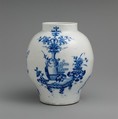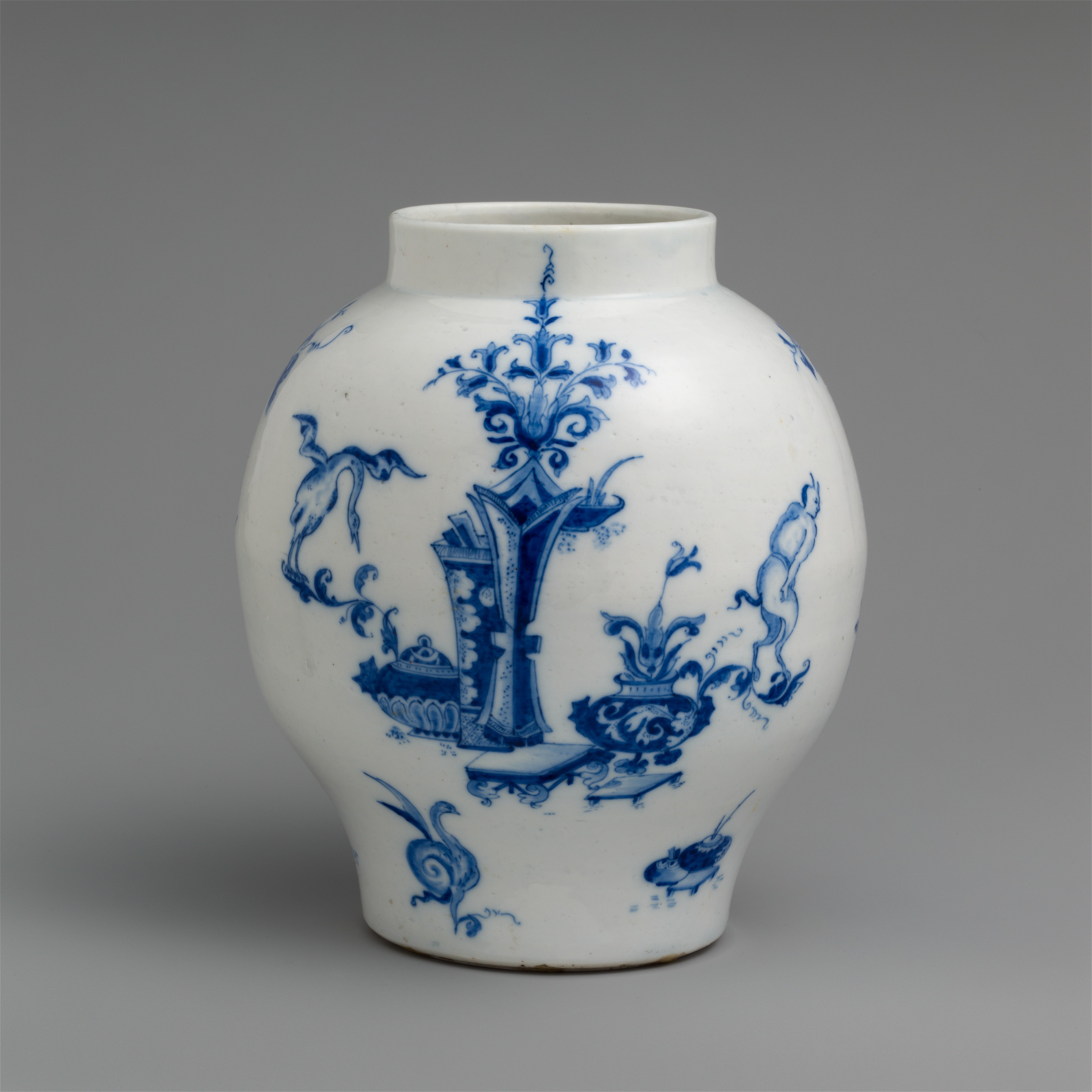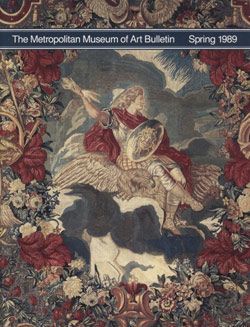Vase
attributed to Saint-Cloud factory French
Decoration after a design by Jacques Androuet Du Cerceau French
Not on view
The Saint-Cloud factory was the first to produce soft-paste porcelain in France on a commercial basis. Established to make faience, or tin- glazed earthenware, the factory experimented with formulas for soft- paste porcelain that was in production by the early 1690s.[1] This vase appears to be one of the earliest works produced at Saint-Cloud, and it belongs to a small group of objects made in the years between 1695 and 1710, which, in the absence of any factory marks, can only be attributed to Saint-Cloud, a factory still in its first period of porcelain manufacturing.[2] A number of these works now believed to have been made at Saint-Cloud were attributed previously to the Poterat factory of Rouen (see 50.211.186),[3] but based on qualities of paste and glaze, as well as stylistic considerations, a Saint-Cloud origin is more persuasive. Nonetheless, the slightly pinkish aspect of the glaze of the present example distinguishes it from the more typical cool, slightly bluish cast of most early Saint-Cloud porcelain, serving as a reminder that attributions are challenging for objects made by small enterprises in their first years of production, especially in a nascent industry, such as porcelain manufacturing at the end of the seventeenth century.
It seems that the earliest products of Saint-Cloud were close imitations of Chinese blue-and-white porcelains,[4] but the factory soon developed its own distinctive style that reflected a blend of Chinese and European motifs. A number of forms based on Chinese porcelains, particularly vases and beakers, were employed by the factory, and the monochromatic palette of cobalt blue applied under the glaze, which the factory used exclusively until the 1720s, was a direct reference to Chinese porcelains. Chinese motifs, such as bands of stylized vegetation and scrolls, were used both as primary decoration and for borders, but European motifs were introduced as early as the mid-1690s. As has been demonstrated by Clare Le Corbeiller, the earliest of these motifs were often taken directly from the work of the French designer and architect Jacques Androuet Du Cerceau (1511–1586).[5] Du Cerceau’s ornament prints were enormously influential in France during the second half of the sixteenth century, and his series Petites Grotesques, first published in 1550, and his series Livre de Grotesques (1566), also known as the Grands Grotesques, widely disseminated a vast vocabulary of ornament designs that were employed by artisans working in a variety of media. His prints contain a seemingly endless repertoire of motifs in the so- called grotesque style that was rooted in Italian Renaissance imagery.[6]
Bertrand Rondot has noted that within this small group of early Saint-Cloud objects decorated with Du Cerceau motifs, two different types of decorative schemes exist.[7] In one type, the porcelain is painted with small-scale motifs arranged symmetrically in a relatively dense manner, occupying much of the surface of the object. In the second type, the placement of the motifs is organized more loosely, and a greater area of the porcelain surface is left undecorated, resulting in compositions that are less dense and lighter in overall effect.[8] It is to this second category that the Museum’s vase belongs.
The vase is decorated with three vignettes composed of motifs derived from Chinese porcelains of the Kangxi period (1662–1722). In each vignette, vases are supported by or grouped around low tables. Two of the vases are based on the ancient Chinese bronze gu form; the other, more familiar vase shapes support stylized flowers and vegetation.[9] The most distinctive feature of the vase’s decorative scheme is the appearance of motifs in one of the vignettes that are taken either from Du Cerceau or from closely related imagery. A standing swan with outspread wings and a downward-curved neck is based on a larger composition in Du Cerceau’s Livre de Grotesques;[10] the winged snail near the base and the two satyrs are strongly reminiscent of motifs found elsewhere in Du Cerceau’s work.[11] It is unclear as to why these motifs would have been chosen for use in combination with imagery commonly found on Chinese porcelains of the seventeenth century, as the Du Cerceau motifs seem to exist entirely independent of the Chinese vases and tables that are the primary decoration of the vase.
Furthermore, it is difficult to explain why motifs from the works of Du Cerceau, which had been executed approximately one hundred and fifty years earlier, would have been selected for use on Saint- Cloud porcelain.[12] While grotesque decoration was fashionable in French court circles during the late seventeenth century, it is unclear if Du Cerceau’s prints were still readily available at that time. It is even less clear how the painters at the factory would have had access to Du Cerceau’s works, especially as their use implies a level of sophisticated taste that is remarkable for a small, experimental enterprise in its first decade of production. In any event, Du Cerceau’s motifs disappear from the decorative vocabulary at Saint-Cloud by the second decade of the eighteenth century to be replaced by more Baroque ornamental schemes that reflect a different style of employing motifs derived from both Renaissance art and from Chinese porcelain.
Footnotes
(For key to shortened references see bibliography in Munger, European Porcelain in the Metropolitan Museum of Art. NY: The Metropolitan Museum of Art, 2018)
1 See Rondot 1999b, p. 19.
2 See Bertrand Rondot in Rondot 1999a, pp. 124–41, nos. 16–33.
3 Le Corbeiller 1999b, p. 43.
4 Rondot in Rondot 1999a, pp. 118–19, nos. 6, 7.
5 See Le Corbeiller 1999b.
6 See French Renaissance in Prints 1994, pp. 371–72, no. 123.
7 Rondot in Rondot 1999a, p. 264.
8 Ibid.
9 For very similar motifs used on Saint- Cloud porcelain, see Sotheby Parke Bernet, New York, sale cat., December 3, 4, and 6, 1975, no. 230, and a vase in the Gardiner Museum, Toronto (G97.4.1).
10 From Du Cerceau’s Livre de Grotesques; see MMA 23.34.2(52), illustrated in Le Corbeiller 1999b, fig. 3- 6.
11 Clare Le Corbeiller has noted that the painters at Saint-Cloud copied Du Cerceau’s motifs faithfully, so it is likely that a specific source exists in his work that has not yet been located; Le Corbeiller, unpublished notes in the curatorial files, Department of European Sculpture and Decorative Arts, The Metropolitan Museum of Art, New York.
12 Le Corbeiller 1999b, p. 45.
Due to rights restrictions, this image cannot be enlarged, viewed at full screen, or downloaded.
This artwork is meant to be viewed from right to left. Scroll left to view more.






